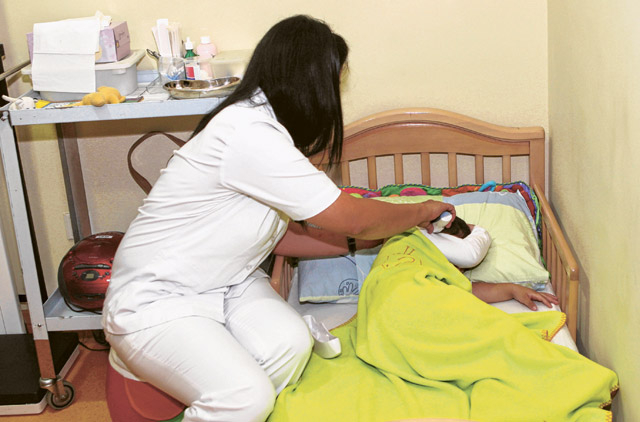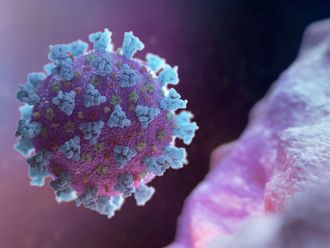
Dubai: It's 11.30 am and students of Emirates British Nursery (EBN) in Mirdif gather at the cafeteria for their snack break. As they take their seats, the little boys and girls of the Minibeast section, aged three-plus, begin to open their lunch boxes. Standing behind them are two teachers, their trained eyes carefully scanning the contents within.
Rice and spinach with a banana, smoked salmon with olives and cucumber, baby carrots with a small orange and apple, humus with bread sticks and some grapes - each of the combos in the boxes must pass their scrutiny before the children can help themselves to it.
The exercise is not without reason. It is to make sure the boxes do not contain foods that the children shouldn't be eating. And it's not just chocolates, chips and fizzy drinks. The no-go foods also include nuts and nut products.
The decision to ban consumption of nuts and nut products in school is not unique to EBN. Rising cases of nut-induced allergies among children have prompted a number of other private schools in Dubai, especially at pre-school and nursery levels, to also go nut-free. The aim is to prevent any untoward incident arising out of an allergic reaction, including the sudden onset of anaphylaxis which can prove fatal (see box).
Although peanuts are the most common allergy-causing food, the ban covers the entire gamut of tree nuts that includes almonds, cashews, chestnuts, hazelnuts, macadamia nuts, pecans, pine nuts, pistachios, walnuts and Brazil nuts. Tracy Penketh, Headmistress of EBN, said 20 of the school's 490 students have nut allergies, with one of them being a case of potential anaphylaxis.
"Incidents of nut allergies have increased dramatically among children in recent years," said Mathew Greening, Deputy Principal, Elementary School section of Dubai International Academy (DIA) where 25 of the 1,800 students have reported nut allergies, a fifth of whom are at risk of anaphylaxis.
These numbers may be a small percentage compared to those who are not allergic but the schools would rather play safe than be sorry since the life-threatening anaphylaxis can occur within seconds of allergens being consumed, necessitating immediate hospitalisation.
Choking hazard
Mary A. Mahoney, Principal, Pre-School, Raffles International School, said, "The ban is to reduce the risk of children who have allergic reactions or intolerance coming into contact with (nuts). It also reduces the risk to children who may well have an allergy or intolerance that has not yet been identified."
"In addition to possible allergies, nuts also carry a choking hazard where small children are concerned," said Savvy Kisani, Director of Little Nest Nursery in Mankhool.
The non-profit Food Allergy & Anaphylaxis Network in Fairfax reported that incidence of peanut and tree nut allergies among children in the US has tripled since 1997.
Although allergy statistics for the UAE are not available, Dr Alya Ahmad, Specialist Pediatrician at City Hospital and spokesperson for the American Academy of Pediatricians in the UAE, said, "Over 50 per cent of clinical illnesses among children present themselves as allergies."
Dr Alya, who deals with at least two to three anaphylaxis emergencies every month, said allergies have many presentations and anaphylaxis could progress from even a simple rash.
Most schools that XPRESS spoke to have full-fledged allergen management systems in place. Mahoney said, "Before a child starts with us we undertake an allergy questionnaire." Should it identify a potential allergy, especially anaphylaxis, stringent risk assessment is done and control measures taken.
"This will involve working closely with the parent, school nurse and doctor as well as with the child's teacher and staff - so that all are aware of the risks and how these should be dealt with both generally and in an emergency," she said.
"All schools are supposed to have an emergency tray stocked with adrenaline injections and emergency kits for managing anaphylaxis," said the school doctor at DIA which, like most other schools, maintains a medical file for every student.
A red alert with an action plan for anaphylaxis is also put up in classrooms of children with severe allergies.
At DIA, for example, one of the kindergarten classrooms has an action plan for a boy who is allergic to almonds, nuts and seeds, oats, chocolate, honey, shellfish and some fruits.
Also spelt out are possible symptoms with details of the emergency medication should the need arise. "Thankfully, we have not had any emergency so far," said the doctor.
Most schools intimate the nut-free policy during admission time. For example, EBN's welcoming guidelines for parents, says, "Please be reminded not to pack any nut products in the snack box. No nuts of any description are allowed at the nursery."
A similar statement is made in the brochure of Little Nest Nursery. Kisani said despite instructions, nuts do make their way into lunch boxes. "But our teachers are vigilant and check the boxes every day," she said.
But is the ban on nuts mandatory? "We have committees at the district level which co-ordinate with the Ministry of Education and food control authorities to agree upon guidelines," said Dr Mariam Matroushi, Director, Health Department, Ministry of Health. As per the ‘Healthy Lunch Box' guidelines of the Dubai Health Authority, permitted fruits and sandwich fillings include dry fruits and nuts.
Is the ban fair?
Under the circumstances, is it fair to impose the nut ban on children without nut allergies? "They are free to eat nuts at home, after school hours. It is too much of a risk to allow nuts in school as kids with allergies could grab or help themselves to these nuts, especially at the nursery level," said Penketh.
While whole nuts are easily identifiable, products with their traces pose a challenge when they are part of cakes or other foods, not all of which are labelled.
"Manufacturers should label ingredients so that people can make informed choices," said Ashraf Shehata, Scientific & Regulatory Affairs Manager of confectionary major MARS GCC. He attributed the increase in allergies to shared assembly lines in production.
"We mention allergens like peanuts, tree nuts, milk, egg, soy, wheat, fish and crustacean shellfish when they are part of the recipe and label them in commonly understood terms," he said.
Did you know?
- anaphylaxis is life-threatening and can occur within
- seconds of the allergens being consumed
What causes allergies?
Allergies are an overreaction of the body's immune system to specific substances called allergens that it misidentifies as harmful. Potential allergens can be anything from dust mites and pollen to insect stings, fragrances and foods, including nuts. Symptoms to nut allergens may begin with a rash, sudden itching of the eyes or face, and within seconds or minutes progress to swelling, breathing difficulties, vomiting, abdominal pain, even anaphylactic shock when a sharp drop in blood pressure and heart failure can cause death.
Most schools have at hand a ready action plan (see right) for anaphylaxis with details of the concerned student.
Possible symptoms of allergies
- itching
- swollen lips or eyes
- sneezing
- red spots around the lips
- breathing problems
- stomach cramps












